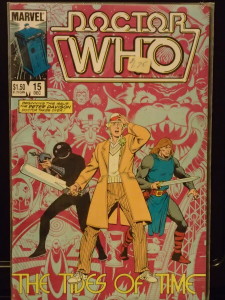In Part 1 of Adventures of an American Whovian, I described how one particular American child growing up in the 1980s became a fan of the television show “Doctor Who” by watching endless repeats of the show on PBS. The cliffhanger of Part 1 was when I discovered a comic store that sold issues of the US “Doctor Who” comic. Looking back, this was the moment that I “regenerated” from being an American kid who was a huge fan of a weird foreign show on PBS to a Doctor Who fan. This regeneration, if you will, came about as a result of discovering information about the show.
Sometime in the Fall or Christmastime 1985, Downtown Crossing, Boston, MA
Although it sounds strange to say, I can pinpoint the purchase of one particular comic as a moment that changed my life. Up to this point, I had a) only thought Doctor Who was a TV show from England and b) been into comics, or Marvel comics more specifically for about 2 years. Until I had begged my mother to take me into Superhero Universe in Downtown Boston that fateful day I had never set foot in a comic store. When I had bought them previously, I got them in convenience stores, cigar stores, bookstores, or any place that had a comics rack. While the racks had the usual big name comics, if they didn’t have it, you weren’t going to get it that month if at all. In the back of all Marvel Comics was a checklist where they had information on each comic they printed in a given month with blurbs about the big stories. Every other month, the checklist showed Doctor Who, but I could never find it on the racks. It was only by chance that I saw out of the corner of my eye the comic store on the upper floor of the building on Winter St. in Downtown Crossing and convinced my mother to go in. To discover that there were actually stores that sold only comic books was one thing- to discover that they were the only place you could get some comics- like Marvel’s Doctor Who- was absolutely mind-bogglingly wicked awesome. For better or worse, I have never really been the same after seeing an entire store full of comics.
When the comic store guy sent me to the back issue bin (he didn’t have the heart to tell me the series had been cancelled in the Summer of 1986), I found the motherlode of Doctor Who back issues and instead of picking Issue #1 with the Tom Baker Doctor, I picked #15, which was the beginning of the Peter Davison run as he was my favorite at the time.
The comic’s cover price was $1.50 or over twice that of a regular Marvel comic of the time (an issue of Spider-Man from that same month cost $0.65). It was only available through comic book stores and was printed on “Baxter Paper,” a glossy stock that still looks good almost 30 years after it was printed. It came inside of a plastic bag just big enough for a comic taped in the back and had been marked up to $1.75. I’m not sure how I convinced my mother to buy what to her was probably the most expensive comic book she had ever seen in her life, but she did.
I was so concerned even then with keeping my investment safe that I didn’t even read it on the subway and bus ride home. When I opened it, however, the wise nature of the investment became apparent. Not only did I get a great Doctor Who comic and a backup story with the Autons, there were several articles on Doctor Who. I learned about Doctor Who history (and that there were six Doctors!), what was currently happening in Doctor Who (they weren’t making new episodes for some reason but they weren’t cancelling it- it was on “hiatus,” whatever that meant), and the name of the original comic in England (“Doctor Who Monthly”). Even the ads were helpful- there were ads for Doctor Who conventions (the one slated for Boston had already happened by the time I got the issue), mail-order merchandise and listings for fan clubs. Little did I know that there were so many other Doctor Who fans out there!
I even wrote one from the list, a club called the Scarf Trailers based in Scranton, PA. I got a hand-written letter from the president of the club on Sixth Doctor stationary (the first time I had ever seen an image of him). She informed me that they were going to be disbanding soon so I never officially joined, but have kept the letter all these years.
Other things I got from the Marvel Doctor Who comics was the number and ordering system of the Doctors, and the news section (called “Who Cares”) informed me that they were going to start showing the Sixth Doctor episodes, followed by the First and Second Doctor! They were eventually shown on WGBH, the Boston PBS station in the spring and summer of 1987.
Whereas once upon a time I would go with my mother on these shopping trips to Downtown Boston under duress, now I had a reason to go. I saved up my allowance and would get to go to the store and buy more issues. Eventually, the comic book guy told me that they carried issues of the British Doctor Who magazine, which had the even more outrageous cover price of $2.75. These issues had even more in-depth articles about Doctor Who then I could have ever imagined and I read them so much they too were well worth the investment.
As if that wasn’t cool enough, I received a surprise when I wandered into the Young Adult section of my public library for the first time. It was there in the Science Fiction section that I discovered that there were Doctor Who books! They were novelizations of old Doctor Who stories instead of new adventures and put out by companies called Target and Pinnacle, but in those days, unless you were lucky enough to see them on TV, this was the only way you were going to get the whole story.
That spring and summer of 1987 were the “golden era” of my Doctor Who fandom. The show was on every weeknight and through the discovery of the Doctor Who comic, magazine, and Target novels. The American Doctor Who comics were the information gateway but Doctor Who Magazine in particular really expanded my knowledge. I soon began throwing around terms like “the Second Doctor” with my brother and father and we all knew what that meant.
All good things must come to an end, however, and this one happened pretty fast. At the end of the summer of 1987, ominous new commercials began to appear on Channel 2. “Doctor Who is moving to a new time zone!” the ads proclaimed. The only problem was that they were changing the time from weekdays at 7:00 PM to Sunday nights at 11:00 PM, which to a kid about to enter the sixth grade whose family didn’t have a VCR, basically meant I was never going to get to watch Doctor Who again.
My dad let me stay up to watch the first episode in the new time slot, which was a “Whovie” (American PBS stations often spliced together the entire story) of the first episode of “The Trial of a Time Lord”. It was pretty awesome to finally see a new episode, but my father made it clear this was a ultra-special treat.
Not too soon after this, however, my family got a VCR (thanks, Dad!). My Dad stayed up late before work on a Monday morning a few times and recorded several Fourth Doctor stories for me (thanks Dad!), but eventually, Channel 2 stopped showing Doctor Who in 1988.
Given the fact that I had yet to find another person my age who liked a) Doctor Who and b) had cable TV, these well-watched videotapes (and the few that they had for rent in US video stores) were all the Doctor Who I had to watch for nearly two years. Did I mention that I know nearly every line of dialogue from “The Ark In Space?” The thing that kept me going during this long dry spell was my growing collection of Doctor Who media. I think it is safe to say that without my comics, Target books, and Doctor Who Magazine, I could have easily slipped back into becoming a casual viewer once more.

